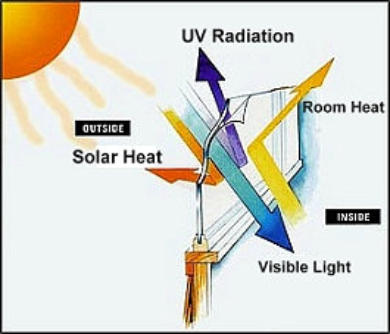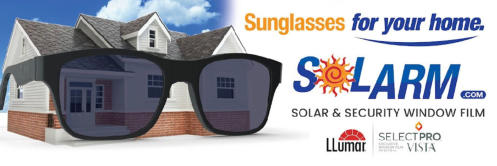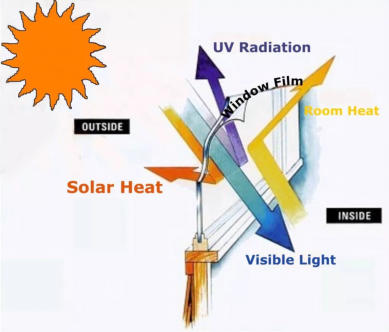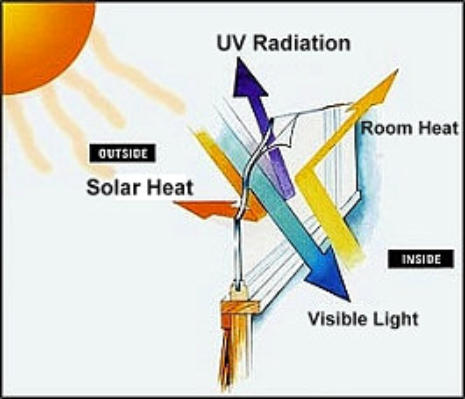817-297-7990




817-297-7990

How Window Film Works
Helping to control the sun is just the beginning.
The concept is simple. The results are
amazing.
Window
film
is
a
sheet
of
strong
polyester
laminate
treated
in
variety
of
highly
engineered
ways
to
improve
the
look
and
performance
of
existing
windows.
One
side
has
a
scratch-resistant
coating
and
the
other
has
an
adhesive that bonds the film to the glass surface.
Architectural
window
films
work
by
controlling
the
passage
of
solar
energy
into
room
spaces,
improving
the
insulating
performance
of
windows,
providing
endless
decorative
opportunities,
or
substantially
reducing
the
safety and security hazards associated with fragile, easily shattered glass.
Solar
control
window
films
for
homes
and
commercial
buildings
help
control
the
sun’s
radiant
energy,
reducing
the
influx
of
heat,
enhancing
outward
visibility
by
reducing
harsh
glare,
and
nearly
eliminating
the
damaging
and
dangerous
effects
of
ultraviolet
light
on
our skin, eyes and interior furnishings.
Low-e
window
film
enhances
the
solar
and
insulating
performance
of
a
building’s
windows,
reducing
excessive
solar
heat
gain
–
reducing
cooling
loads
and
peak
demand.
They
also
provide
year-round
benefits,
reducing
heating
costs
by
improving
window
insulating
performance.
Safety
and
security
window
films
are
many
times
thicker
than
standard
films
and
provide
a
tougher
barrier
against
forced
intrusion.
And
in
the
event
of
windstorms,
earthquakes,
and
explosions,
they
work
to
help
shield
occupants
and
by-standers
against
flying
glass
fragments.

Protect people and furnishings from harmful UVA rays.
The
sun
offers
many
benefits,
such
as
increased
productivity
and
reduced
reliance
on
electric
lighting;
but
the
sun’s
UV
rays
can
also
damage skin and building assets if they’re not controlled.
UV
rays
can
penetrate
windows
in
commercial
buildings,
homes
and
automobiles,
exposing
occupants
and
interior
furnishings
to
an
invisible
danger.
UV
rays
can
fade
furniture,
wall
coverings,
artwork,
fabric,flooring
and
window
merchandise
displays.
UVA
rays
are
also
linked
to
skin
cancer.
This
exposure
is
cumulative,
so
the
total
damage
an
occupant
receives
is
directly
related
to
how
often
they’re
exposed to UV rays.
LLumar
solar
control
window
film
is
one
of
the
easiest
ways
to
mitigate
UV
damage.
It
can
block
more
than
99%
of
harmful
UV
Rays
while
offering
unobstructed
views,
allowing
natural
daylight
inside.
Window
films
also
reduce
solar
heat
gain,
which
may
lower
cooling
costs.
Newer
low-e
window
films
offer
year-round
HVAC
savings
by
helping
keep
radiant
heat
inside
in
the
winter
and
outside
in
the
summer. Window film is recommended by The Skin Cancer Foundation as part of a comprehensive skin care program.


Automotive
tint
and
flat
glass
tint
are
very
similar,
but
they
are
also
very
different.
Automotive
tint,
applied
to
trucks
and
cars,
and
flat
glass
tint,
applied
to
exterior
windows
or
doors
in
a
building,
both
have
the
same
purpose;
to
keep
the
interior
space
of
the
car,
home,
or
office
more
comfortable.
Intense
heat
and
glare
caused
by
direct
sunlight
can
make
the
inside
of
a
car,
and
the
inside
of
a
room quite unbearable.
Window
tint
helps
reduce
heat
build
up
and
glare,
which
can
cause
discomfort.
Another
benefit
for
window
tint
is
that
it
offers
UV
protection.
For
homes
and
offices,
installing
window
tint
can
prevent
damage
to
your
skin
when
you
are
enjoying
a
seat
by
the
window,
and helps prevent premature damage to interior furnishings and flooring.
AUTOMOTIVE TINT VS FLAT GLASS TINT
WHY IS AUTOMOTIVE TINT DIFFERENT FROM FLAT GLASS TINT?
Unlike
flat
glass,
automotive
tint
absorbs
the
sun’s
energy.
It
is
when
the
car
is
in
motion
that
it
pulls
the
heat
away,
cooling
the
interior
of
the
car.
When
the
car
is
not
moving,
it
can
actually
cause
the
car
to
heat
up
more
than
without
the
film.
Because
of
Transportation laws, there is a limitation to how dark and reflective automotive tint is allowed to be.
Buildings
do
not
fall
under
the
same
restriction
as
cars
which
means
reflective
properties
and
darker
tints
are
allowed.
Flat
glass
tint
stops
the
heat
of
the
sun
right
at
the
window,
preventing
the
windows
from
heating
up
and
not
requiring
the
building
to
be
'in
motion' for the cooling effect to take place.
CAN AUTOMOTIVE TINT BE INSTALLED ON FLAT GLASS?
Automotive
tint
is
heat
shrinkable
for
installation
so
that
it
can
be
applied
to
the
curved
surface
of
a
car
window.
APPLYING
AUTOMOTIVE TINT TO FLAT GLASS CAN CAUSE BREAKAGE.
Therefore,
as
much
as
automotive
and
flat
glass
tints
are
very
similar,
in
that
they
offer
solar
protection
and
increased
durability,
they
are
designed
for
different
applications.
Now,
if
you
could
build
your
house
or
office
to
be
aerodynamic
and
move
down
the
road,
maybe
then
automotive
tint
could
be
applied
to
your
home
or
office.
Until
then,
automotive
tint
can
only
be
applied
to
cars
and
trucks,
and
flat
glass tint used on homes and office buildings.
WHAT IS THE DIFFERENCE BETWEEN AUTOMOTIVE TINT AND FLAT GLASS TINT?


817-297-7990

How Window Film Works
Helping to control the sun is
just the beginning.
The concept is simple.
The results are amazing.
Window
film
is
a
sheet
of
strong
polyester
laminate
treated
in
variety
of
highly
engineered
ways
to
improve
the
look
and
performance
of
existing
windows.
One
side
has
a
scratch-
resistant
coating
and
the
other
has
an
adhesive
that bonds the film to the glass surface.
Architectural
window
films
work
by
controlling
the
passage
of
solar
energy
into
room
spaces,
improving
the
insulating
performance
of
windows,
providing
endless
decorative
opportunities,
or
substantially
reducing
the
safety
and
security
hazards
associated
with
fragile, easily shattered glass.
Solar
control
window
films
for
homes
and
commercial
buildings
help
control
the
sun’s
radiant
energy,
reducing
the
influx
of
heat,
enhancing
outward
visibility
by
reducing
harsh
glare,
and
nearly
eliminating
the
damaging
and
dangerous
effects
of
ultraviolet
light
on
our
skin,
eyes and interior furnishings.
Low-e
window
film
enhances
the
solar
and
insulating
performance
of
a
building’s
windows,
reducing
excessive
solar
heat
gain
–
reducing
cooling
loads
and
peak
demand.
They
also
provide
year-round
benefits,
reducing
heating
costs
by
improving window insulating performance.
Safety
and
security
window
films
are
many
times
thicker
than
standard
films
and
provide
a
tougher
barrier
against
forced
intrusion.
And
in
the
event
of
windstorms,
earthquakes,
and
explosions,
they
work
to
help
shield
occupants
and by-standers against flying glass fragments.
Protect people and
furnishings from
harmful UVA rays.
The
sun
offers
many
benefits,
such
as
increased
productivity
and
reduced
reliance
on
electric
lighting;
but
the
sun’s
UV
rays
can
also
damage
skin
and
building
assets
if
they’re
not
controlled.
UV
rays
can
penetrate
windows
in
commercial
buildings,
homes
and
automobiles,
exposing
occupants
and
interior
furnishings
to
an
invisible
danger.
UV
rays
can
fade
furniture,
wall
coverings,
artwork,
fabric,flooring
and
window
merchandise
displays.
UVA
rays
are
also
linked
to
skin
cancer.
This
exposure
is
cumulative,
so
the
total
damage
an
occupant
receives
is
directly
related to how often they’re exposed to UV rays.
LLumar
solar
control
window
film
is
one
of
the
easiest
ways
to
mitigate
UV
damage.
It
can
block
more
than
99%
of
harmful
UV
Rays
while
offering
unobstructed
views,
allowing
natural
daylight
inside.
Window
films
also
reduce
solar
heat
gain,
which
may
lower
cooling
costs.
Newer
low-e
window
films
offer
year-round
HVAC
savings
by
helping
keep
radiant
heat
inside
in
the
winter
and
outside
in
the
summer.
Window
film
is
recommended
by
The
Skin
Cancer
Foundation
as
part of a comprehensive skin care program.


Automotive
tint
and
flat
glass
tint
are
very
similar,
but
they
are
also
very
different.
Automotive
tint,
applied
to
trucks
and
cars,
and
flat
glass
tint,
applied
to
exterior
windows
or
doors
in
a
building,
both
have
the
same
purpose;
to
keep
the
interior
space
of
the
car,
home,
or
office
more
comfortable.
Intense
heat
and
glare
caused
by
direct
sunlight
can
make
the
inside
of
a
car, and the inside of a room quite unbearable.
Window
tint
helps
reduce
heat
build
up
and
glare,
which
can
cause
discomfort.
Another
benefit
for
window
tint
is
that
it
offers
UV
protection.
For
homes
and
offices,
installing
window
tint
can
prevent
damage
to
your
skin
when
you
are
enjoying
a
seat
by
the
window,
and
helps
prevent
premature
damage
to
interior
furnishings and flooring.
AUTOMOTIVE TINT VS FLAT
GLASS TINT
WHY IS AUTOMOTIVE TINT DIFFERENT FROM FLAT
GLASS TINT?
Unlike
flat
glass,
automotive
tint
absorbs
the
sun’s
energy.
It
is
when
the
car
is
in
motion
that
it
pulls
the
heat
away,
cooling
the
interior
of
the
car.
When
the
car
is
not
moving,
it
can
actually
cause
the
car
to
heat
up
more
than
without
the
film.
Because
of
Transportation
laws,
there
is
a
limitation
to
how
dark
and
reflective
automotive
tint is allowed to be.
Buildings
do
not
fall
under
the
same
restriction
as
cars
which
means
reflective
properties
and
darker
tints
are
allowed.
Flat
glass
tint
stops
the
heat
of
the
sun
right
at
the
window,
preventing
the
windows
from
heating
up
and
not
requiring
the
building
to
be
'in
motion'
for
the
cooling effect to take place.
CAN AUTOMOTIVE TINT BE
INSTALLED ON FLAT GLASS?
Automotive
tint
is
heat
shrinkable
for
installation
so
that
it
can
be
applied
to
the
curved
surface
of
a
car
window.
APPLYING
AUTOMOTIVE
TINT
TO
FLAT
GLASS CAN CAUSE BREAKAGE.
Therefore,
as
much
as
automotive
and
flat
glass
tints
are
very
similar,
in
that
they
offer
solar
protection
and
increased
durability,
they
are
designed
for
different
applications.
Now,
if
you
could
build
your
house
or
office
to
be
aerodynamic
and
move
down
the
road,
maybe
then
automotive
tint
could
be
applied
to
your
home
or
office.
Until
then,
automotive
tint
can
only
be
applied
to
cars
and
trucks,
and
flat
glass
tint used on homes and office buildings.
WHAT IS THE DIFFERENCE
BETWEEN AUTOMOTIVE TINT
AND FLAT GLASS TINT?





817-297-7990

817-297-7990





817-297-7990

How Window Film Works
Helping to control the sun is just the beginning.
The concept is simple. The results are
amazing.
Window
film
is
a
sheet
of
strong
polyester
laminate
treated
in
variety
of
highly
engineered
ways
to
improve
the
look
and
performance
of
existing
windows.
One
side
has
a
scratch-resistant
coating
and
the
other
has
an
adhesive that bonds the film to the glass surface.
Architectural
window
films
work
by
controlling
the
passage
of
solar
energy
into
room
spaces,
improving
the
insulating
performance
of
windows,
providing
endless
decorative
opportunities,
or
substantially
reducing
the
safety and security hazards associated with fragile, easily shattered glass.
Solar
control
window
films
for
homes
and
commercial
buildings
help
control
the
sun’s
radiant
energy,
reducing
the
influx
of
heat,
enhancing
outward
visibility
by
reducing
harsh
glare,
and
nearly
eliminating
the
damaging
and
dangerous
effects
of
ultraviolet
light
on
our skin, eyes and interior furnishings.
Low-e
window
film
enhances
the
solar
and
insulating
performance
of
a
building’s
windows,
reducing
excessive
solar
heat
gain
–
reducing
cooling
loads
and
peak
demand.
They
also
provide
year-round
benefits,
reducing
heating
costs
by
improving
window
insulating
performance.
Safety
and
security
window
films
are
many
times
thicker
than
standard
films
and
provide
a
tougher
barrier
against
forced
intrusion.
And
in
the
event
of
windstorms,
earthquakes,
and
explosions, they work to help shield occupants and by-standers against flying glass fragments.

Protect people and furnishings from harmful UVA rays.
The
sun
offers
many
benefits,
such
as
increased
productivity
and
reduced
reliance
on
electric
lighting;
but
the
sun’s
UV
rays
can
also
damage skin and building assets if they’re not controlled.
UV
rays
can
penetrate
windows
in
commercial
buildings,
homes
and
automobiles,
exposing
occupants
and
interior
furnishings
to
an
invisible
danger.
UV
rays
can
fade
furniture,
wall
coverings,
artwork,
fabric,flooring
and
window
merchandise
displays.
UVA
rays
are
also
linked
to
skin
cancer.
This
exposure
is
cumulative,
so
the
total
damage
an
occupant
receives
is
directly
related
to
how
often
they’re
exposed to UV rays.
LLumar
solar
control
window
film
is
one
of
the
easiest
ways
to
mitigate
UV
damage.
It
can
block
more
than
99%
of
harmful
UV
Rays
while
offering
unobstructed
views,
allowing
natural
daylight
inside.
Window
films
also
reduce
solar
heat
gain,
which
may
lower
cooling
costs.
Newer
low-e
window
films
offer
year-round
HVAC
savings
by
helping
keep
radiant
heat
inside
in
the
winter
and
outside
in
the
summer. Window film is recommended by The Skin Cancer Foundation as part of a comprehensive skin care program.


Automotive
tint
and
flat
glass
tint
are
very
similar,
but
they
are
also
very
different.
Automotive
tint,
applied
to
trucks
and
cars,
and
flat
glass
tint,
applied
to
exterior
windows
or
doors
in
a
building,
both
have
the
same
purpose;
to
keep
the
interior
space
of
the
car,
home,
or
office
more
comfortable.
Intense
heat
and
glare
caused
by
direct
sunlight
can
make
the
inside
of
a
car,
and
the
inside
of
a
room quite unbearable.
Window
tint
helps
reduce
heat
build
up
and
glare,
which
can
cause
discomfort.
Another
benefit
for
window
tint
is
that
it
offers
UV
protection.
For
homes
and
offices,
installing
window
tint
can
prevent
damage
to
your
skin
when
you
are
enjoying
a
seat
by
the
window,
and helps prevent premature damage to interior furnishings and flooring.
AUTOMOTIVE TINT VS FLAT GLASS TINT
WHY IS AUTOMOTIVE TINT DIFFERENT FROM FLAT GLASS TINT?
Unlike
flat
glass,
automotive
tint
absorbs
the
sun’s
energy.
It
is
when
the
car
is
in
motion
that
it
pulls
the
heat
away,
cooling
the
interior
of
the
car.
When
the
car
is
not
moving,
it
can
actually
cause
the
car
to
heat
up
more
than
without
the
film.
Because
of
Transportation laws, there is a limitation to how dark and reflective automotive tint is allowed to be.
Buildings
do
not
fall
under
the
same
restriction
as
cars
which
means
reflective
properties
and
darker
tints
are
allowed.
Flat
glass
tint
stops
the
heat
of
the
sun
right
at
the
window,
preventing
the
windows
from
heating
up
and
not
requiring
the
building
to
be
'in
motion' for the cooling effect to take place.
CAN AUTOMOTIVE TINT BE INSTALLED ON FLAT GLASS?
Automotive
tint
is
heat
shrinkable
for
installation
so
that
it
can
be
applied
to
the
curved
surface
of
a
car
window.
APPLYING
AUTOMOTIVE TINT TO FLAT GLASS CAN CAUSE BREAKAGE.
Therefore,
as
much
as
automotive
and
flat
glass
tints
are
very
similar,
in
that
they
offer
solar
protection
and
increased
durability,
they
are
designed
for
different
applications.
Now,
if
you
could
build
your
house
or
office
to
be
aerodynamic
and
move
down
the
road,
maybe
then
automotive
tint
could
be
applied
to
your
home
or
office.
Until
then,
automotive
tint
can
only
be
applied
to
cars
and
trucks,
and
flat
glass tint used on homes and office buildings.
WHAT IS THE DIFFERENCE BETWEEN AUTOMOTIVE TINT AND FLAT GLASS TINT?





















